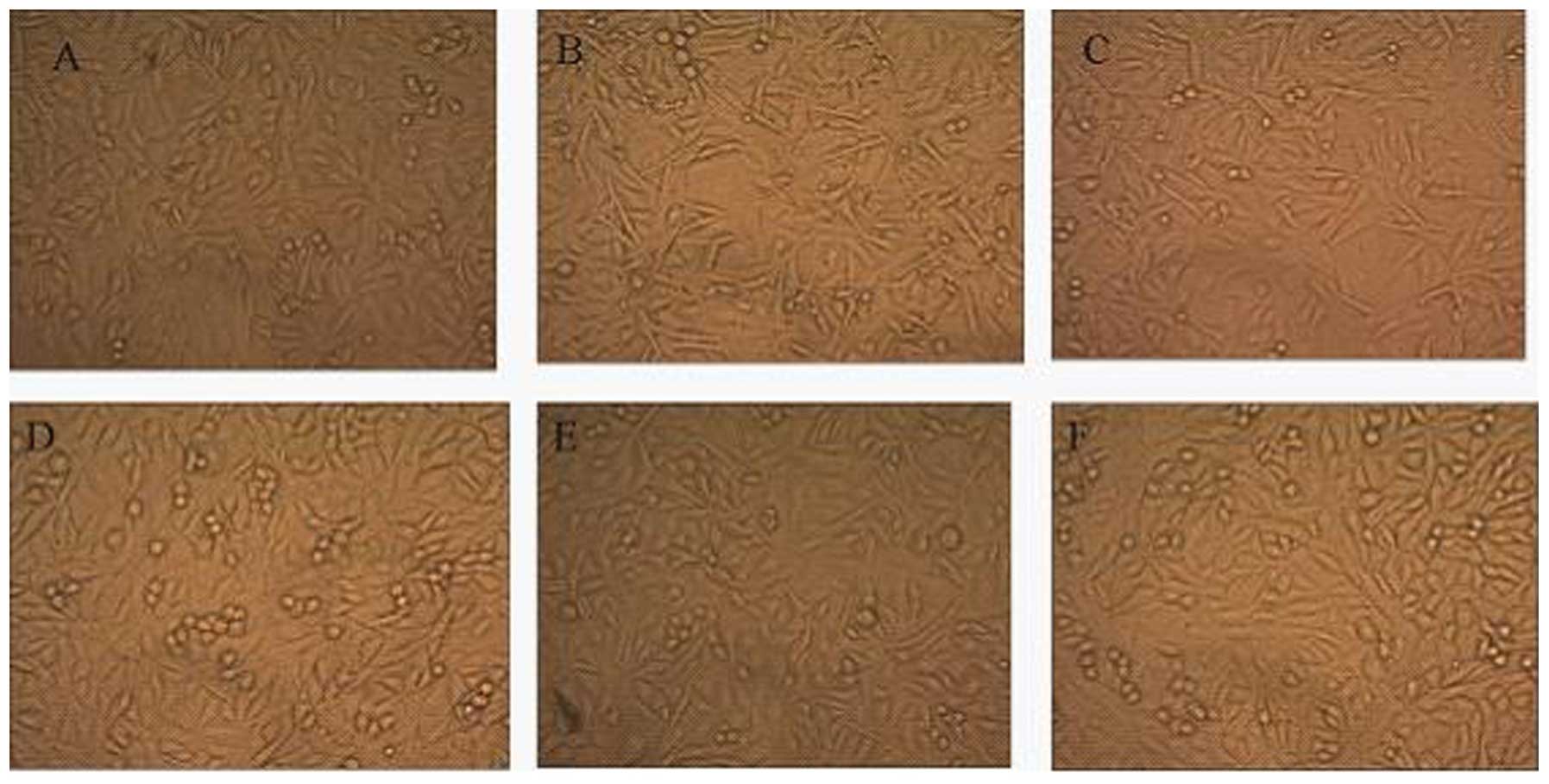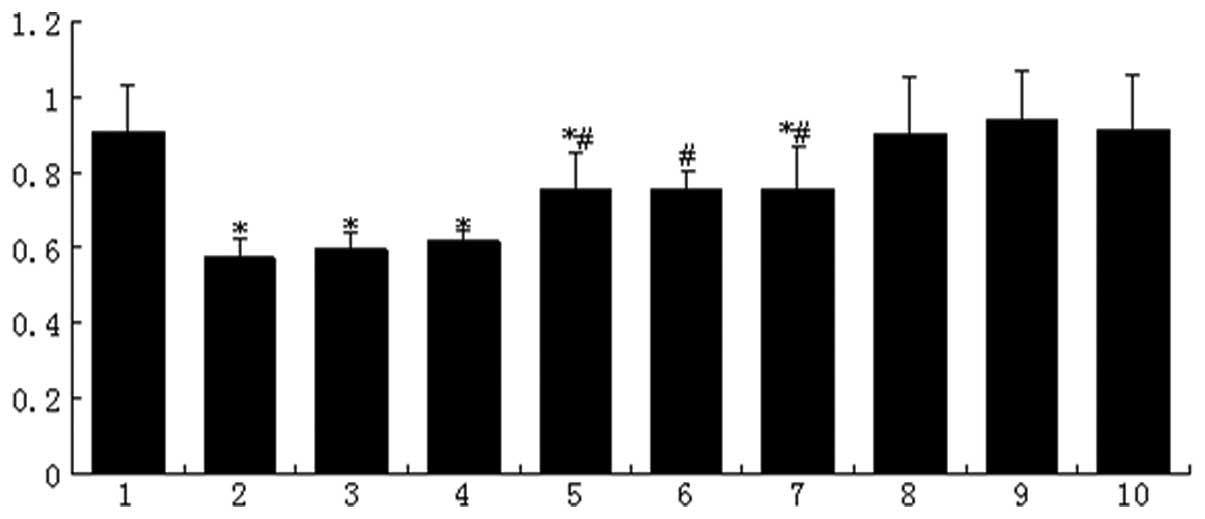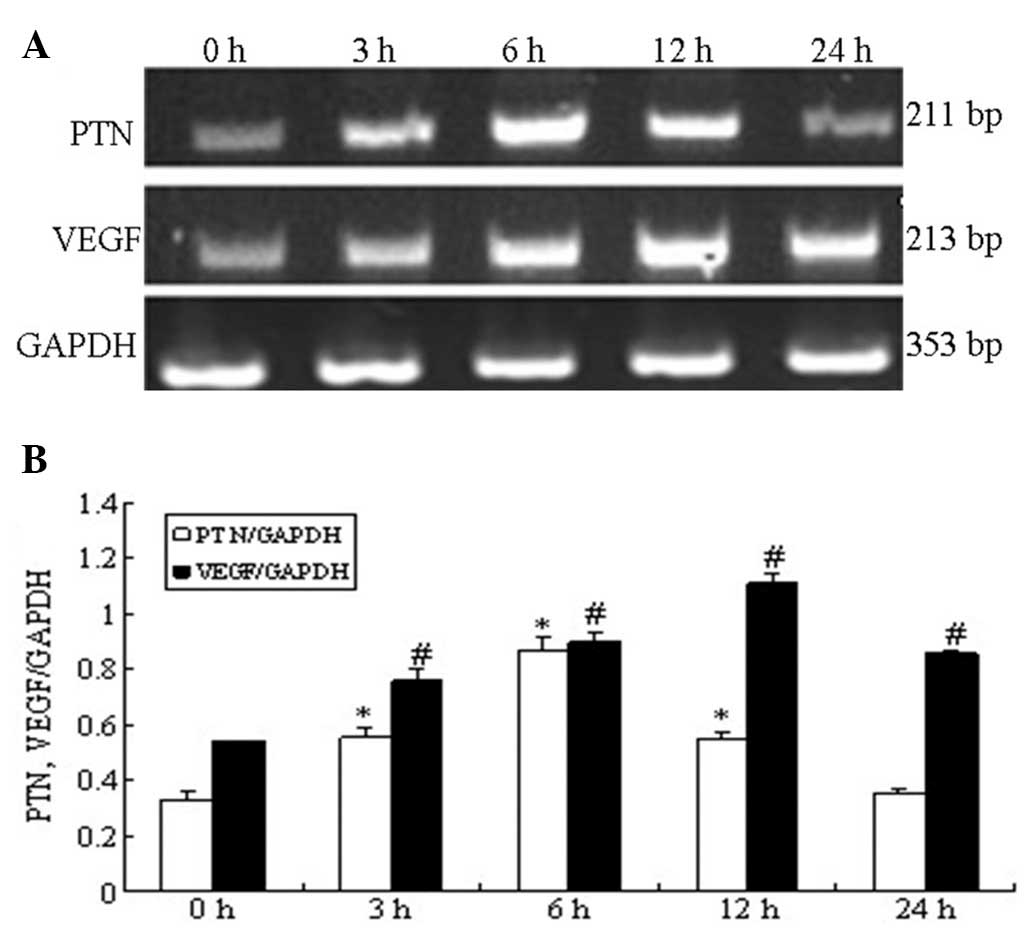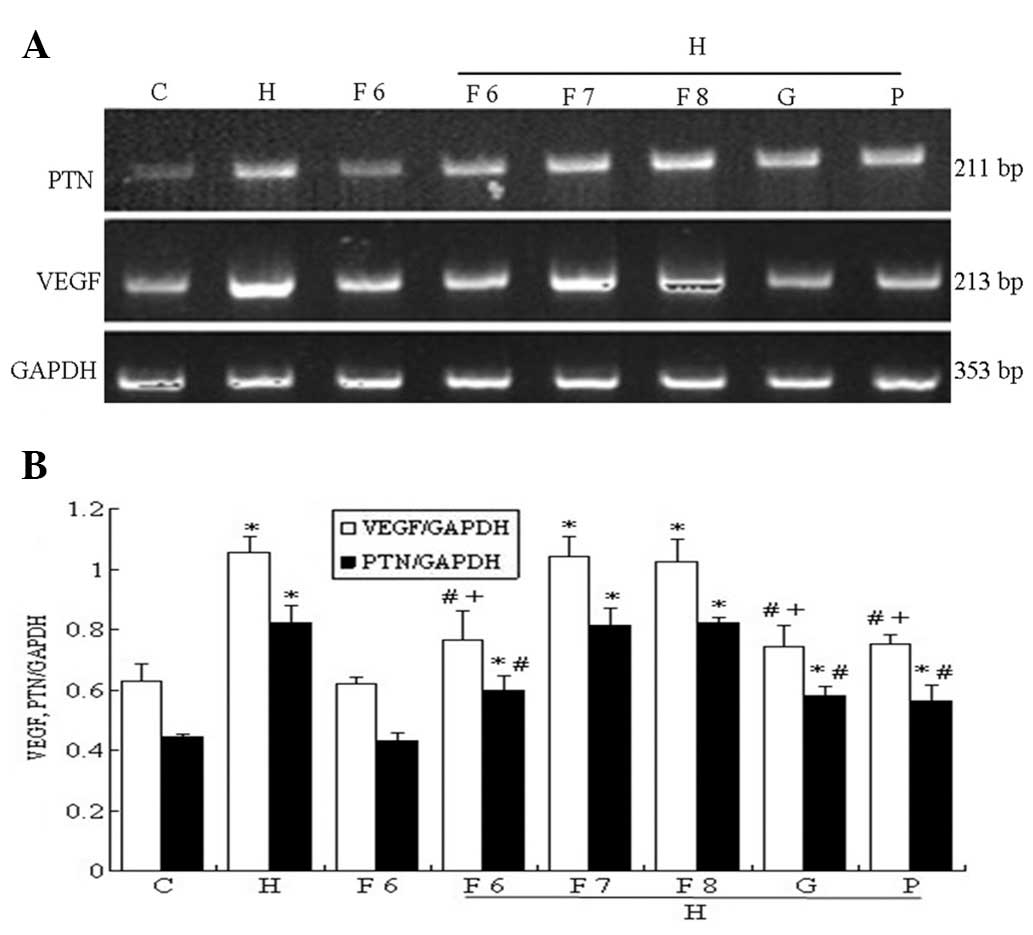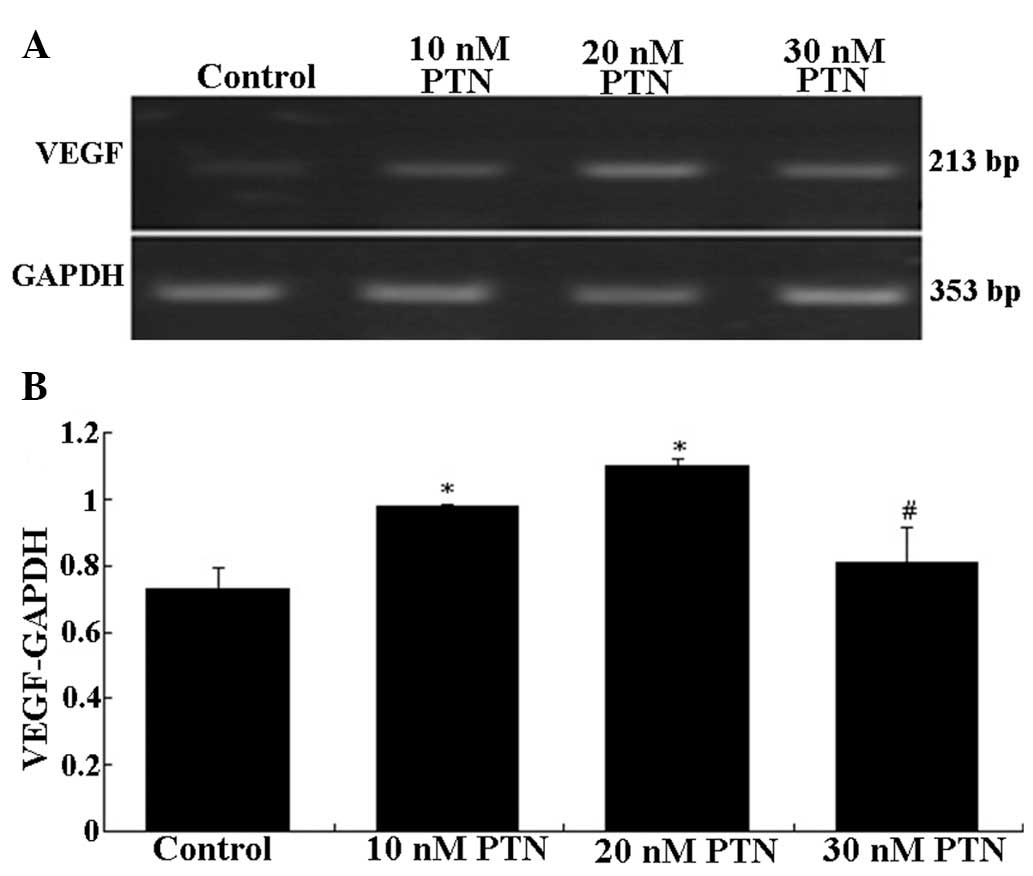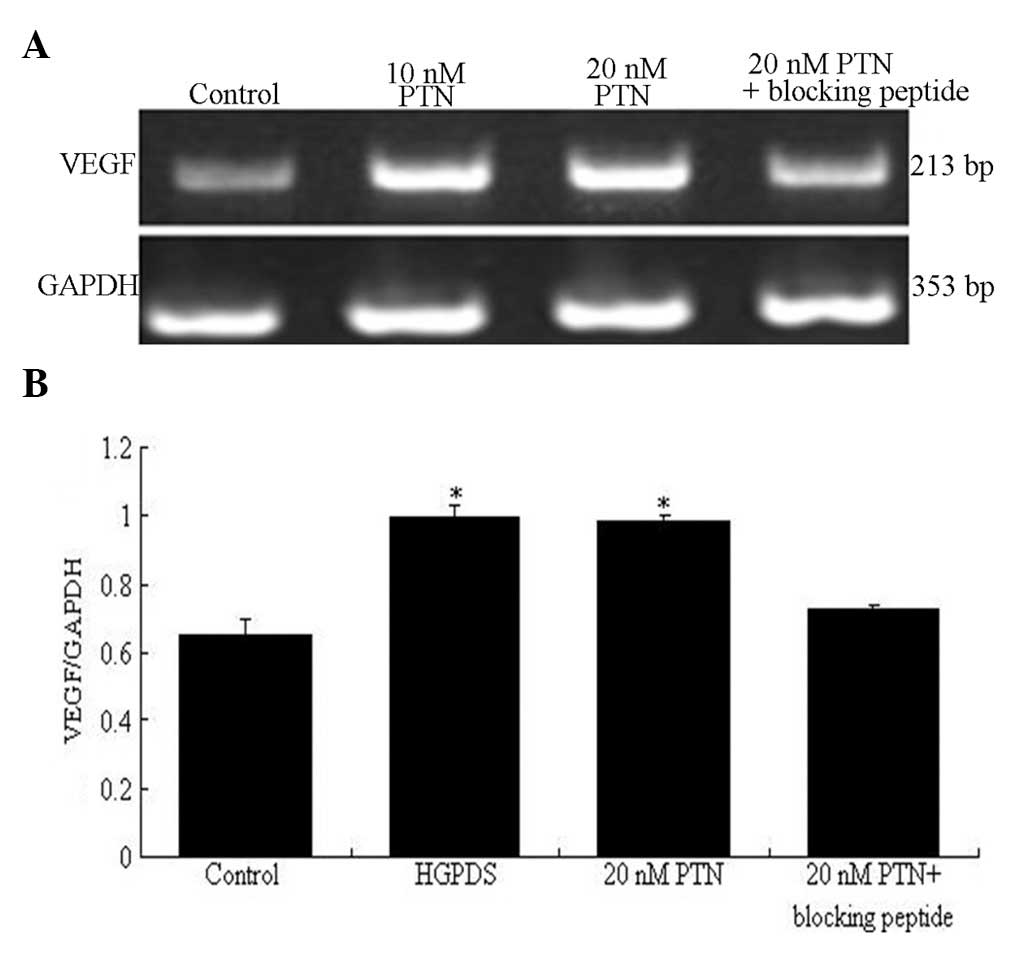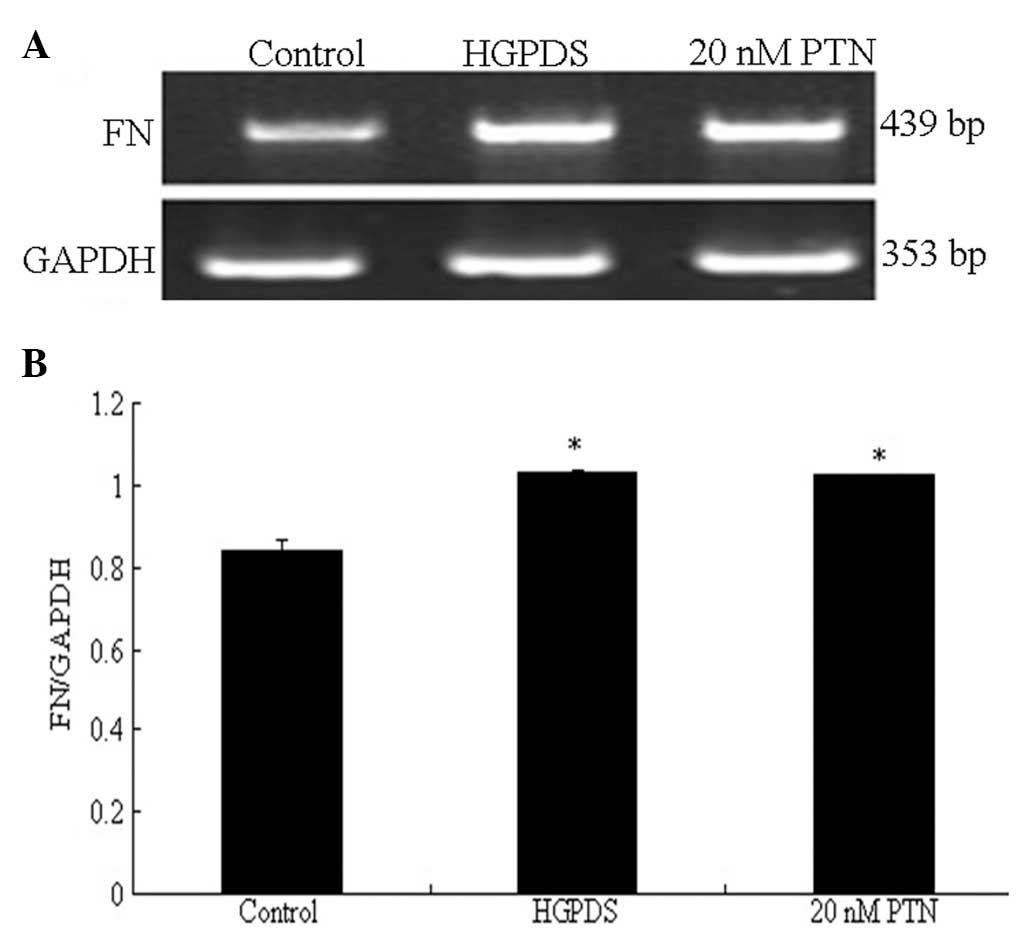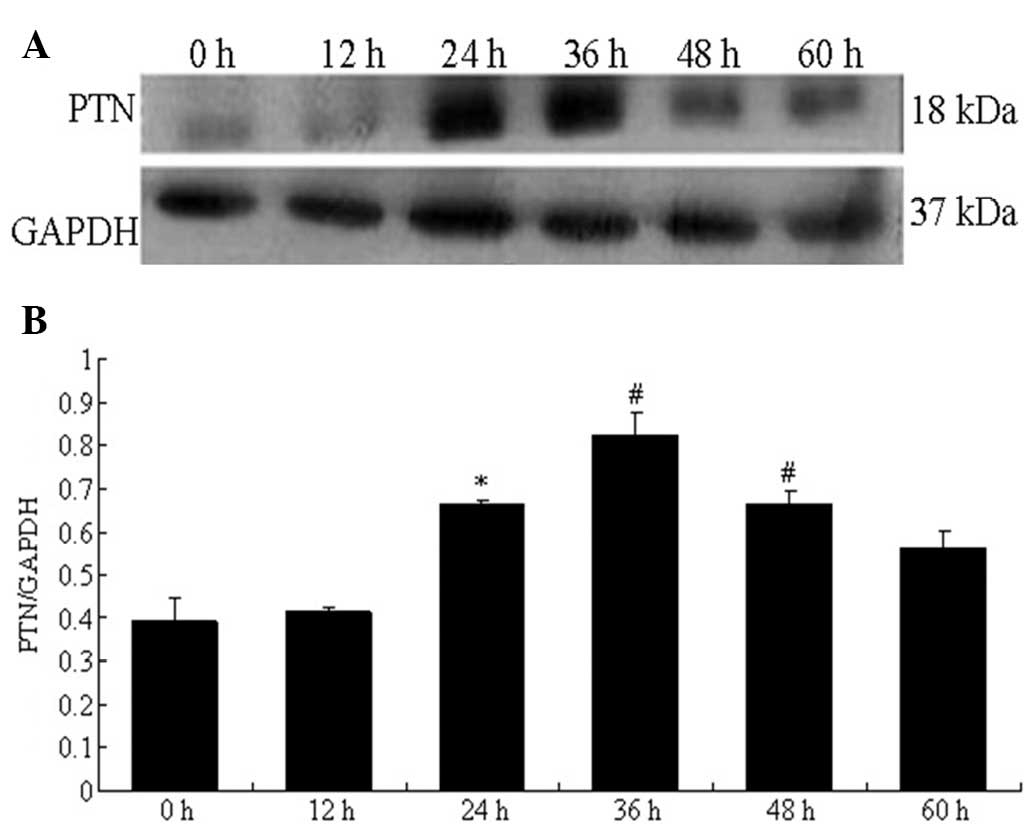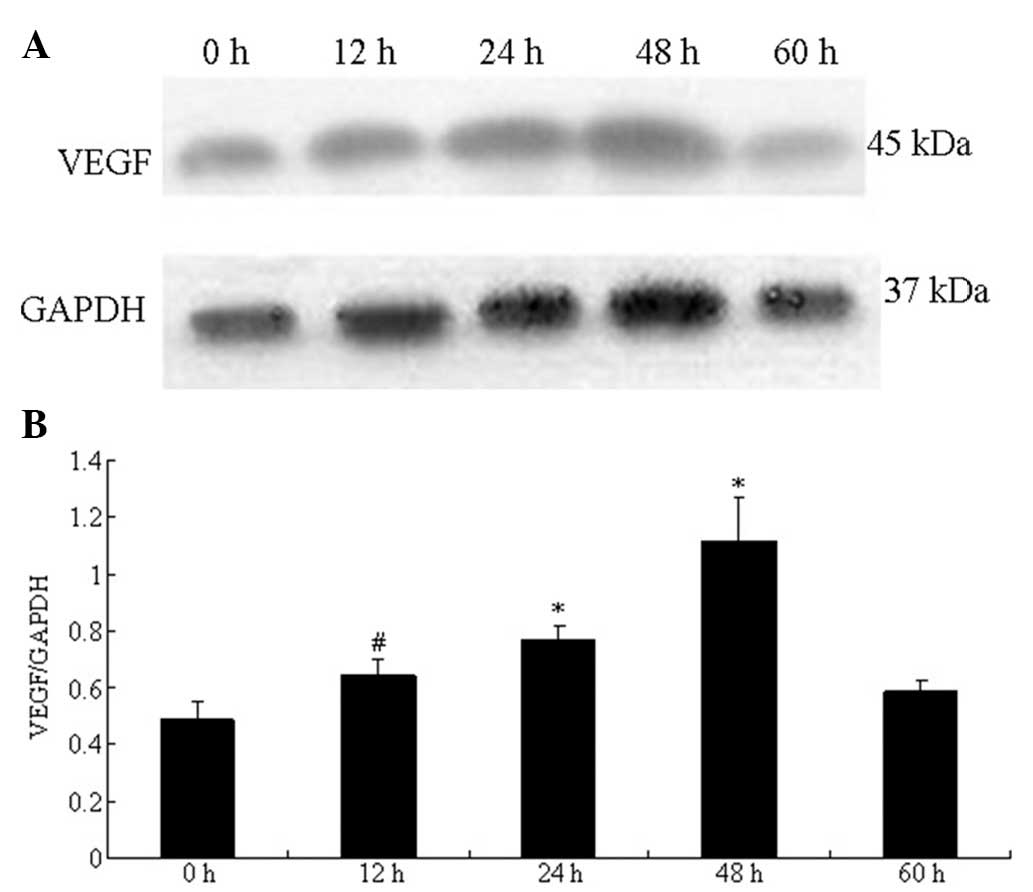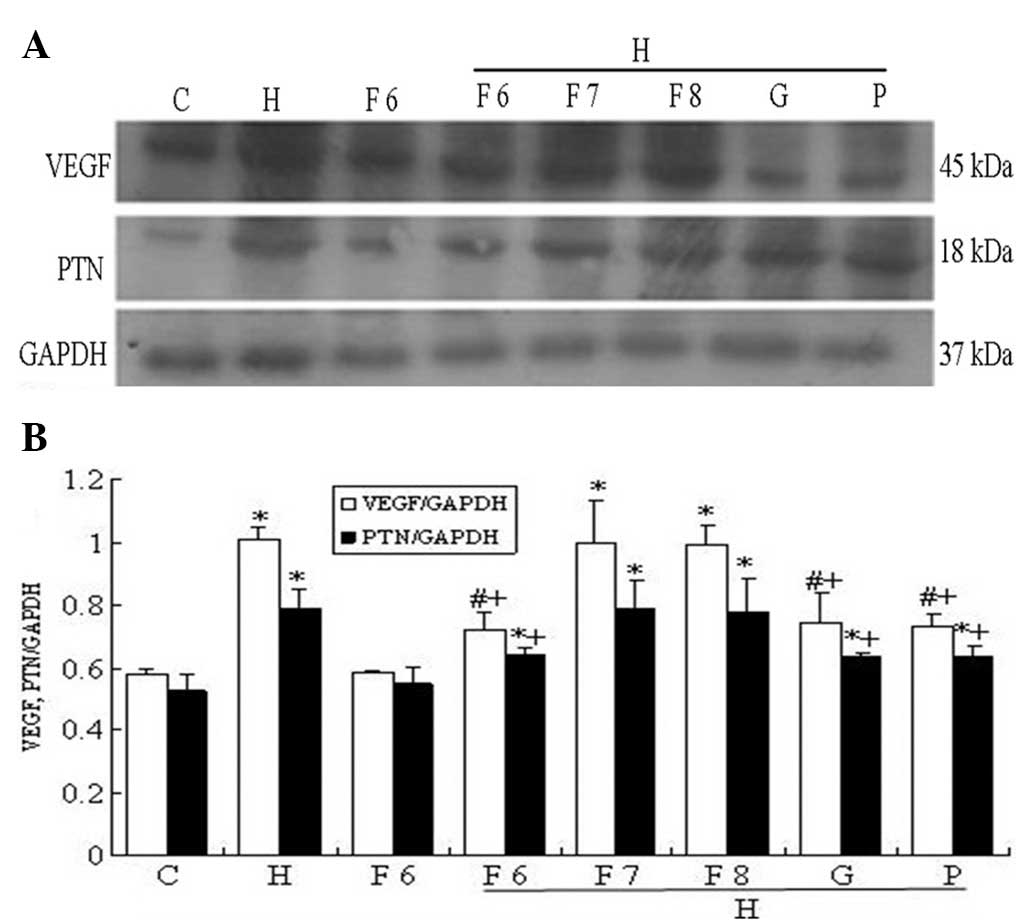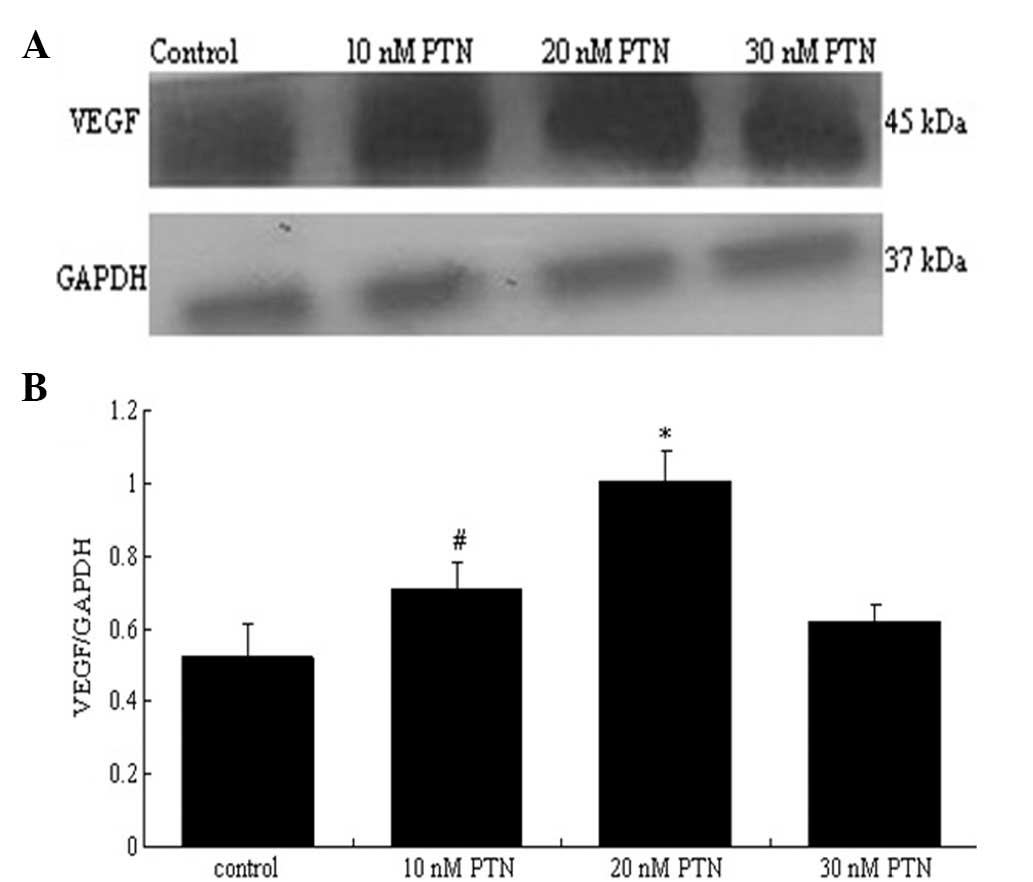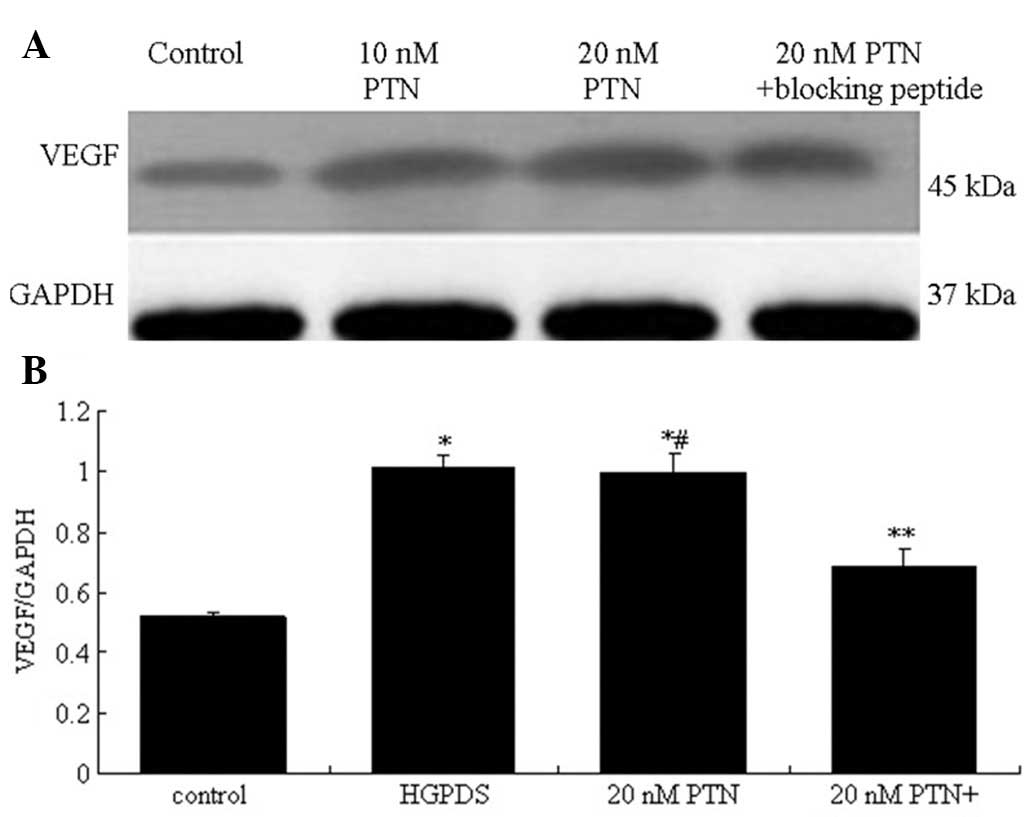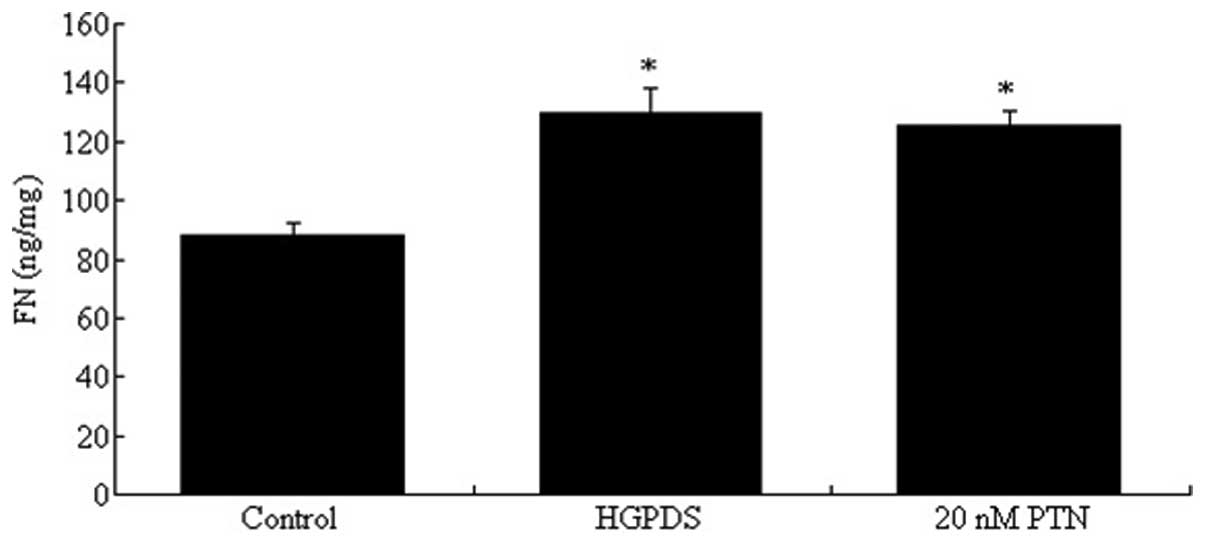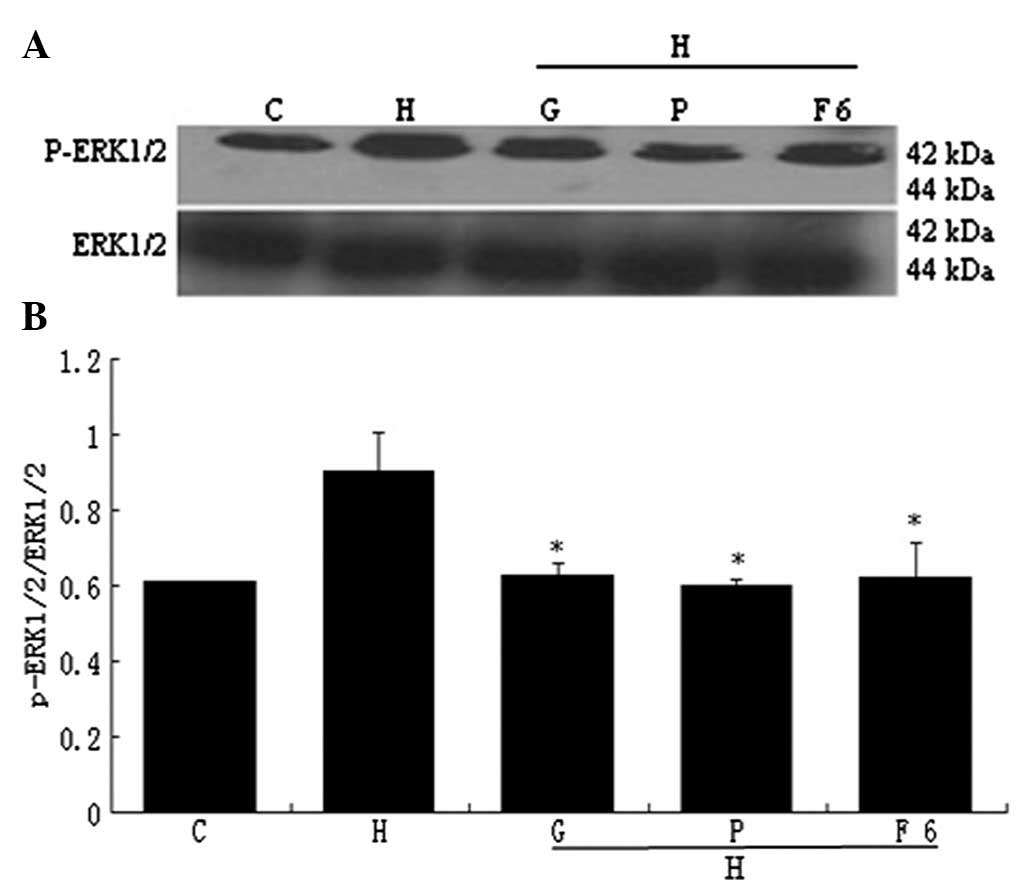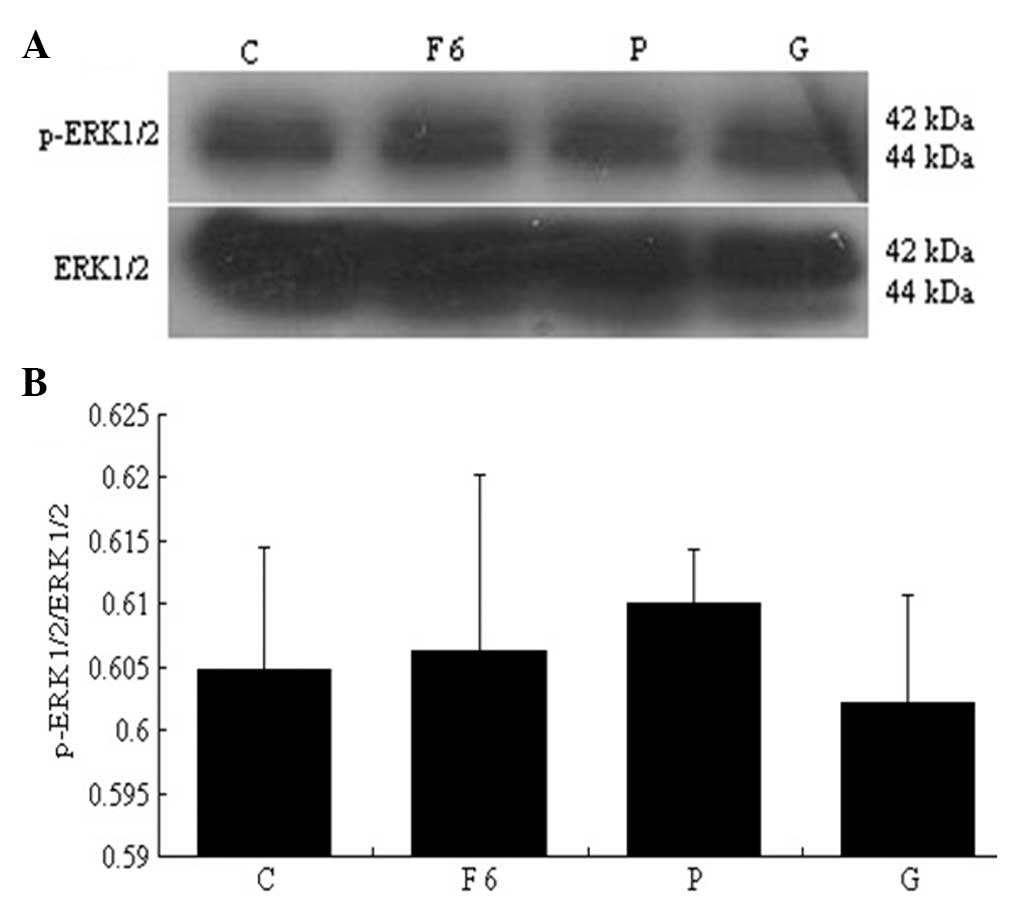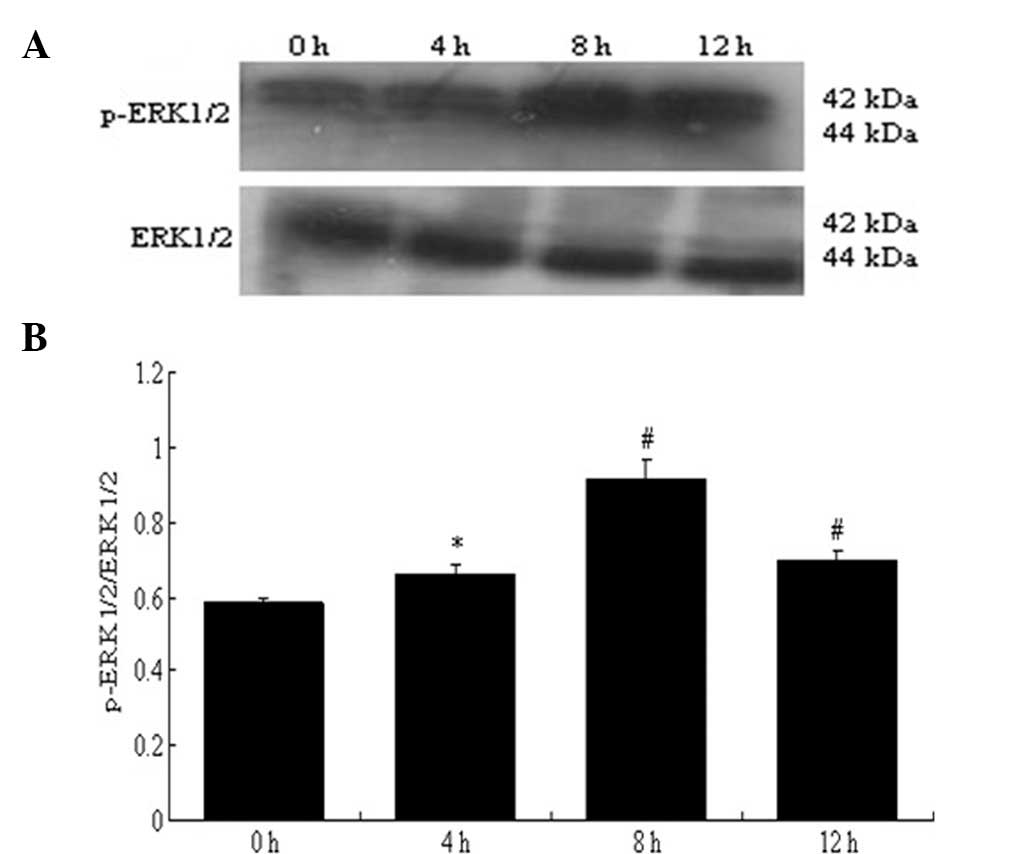High-glucose-based peritoneal dialysis solution induces the upregulation of VEGF expression in human peritoneal mesothelial cells: The role of pleiotrophin
- Authors:
- Published online on: September 12, 2013 https://doi.org/10.3892/ijmm.2013.1491
- Pages: 1150-1158
Abstract
Introduction
Peritoneal dialysis (PD) has been used as the main therapy for the treatment of end-stage renal disease (ESRD). A single layer of mesothelial cells (MCs) covers an entire peritoneal cavity. This layer of MCs can serve not only as a biological barrier but also as a secretory organ. In addition, MCs have the ability to synthesize and secrete various substances, such as vascular endothelial growth factor (VEGF) and transforming growth factor (TGF)-β and these substances participate in the functional alteration of the peritoneal membrane (1–3). Sterile dialysis solutions universally applied are non-biocompatible, and can cause inflammation in the sub-mesothelium. The inflammation process may sequentially lead to fibrosis and angiogenesis, eventually leading to ultrafiltration failure (4). In patients on long-term PD using conventional peritoneal dialysis solutions (PDS), alterations in the structure and function of the peritoneal membrane, including increased peritoneal membrane permeability and ultrafiltration failure, eventually lead to peritoneal fibrosis (6,7). The substances secreted by MCs play an important role in this process. Previous studies have suggested that VEGF plays an important role in the alteration of peritoneal membrane permeability (8,9). Pleiotrophin (PTN), initially identified as a neurite growth/guidance-regulating protein, is an 18- or 15-kDa heparin-binding protein, which belongs to the midkine family (10,11). PTN plays a variety of roles, including roles in proliferation and apoptosis and has mitogenic, angiogenic and oncogenic activities (12). In the studies by Kohashi et al (13) and Henger et al (14), PNT was reported to participate in fibrosis in different organs. A previous study demonstrated that the increase in peritoneal membrane permeability and fibrosis induced by chlorhexidine gluconate (CG) was attenuated in PTN knockout mice (15).
In this study, we investigated whether a high-glucose-based peritoneal dialysis solution (HGPDS) directly affects VEGF and PTN expression and whether this effect occurs through the modulation of the serum/glucocorticoid-regulated kinase 1 (SGK1)-ERK1/2 signaling pathway in human peritoneal mesothelial cells (HPMCs). We further explored the role of PTN in the modulation of VEGF expression in HPMCs.
Materials and methods
Materials
Fluvastatin (Flu) was obtained as a gift from Novartis Pharma Ltd., Shangai, China. Dulbecco’s modified Eagle’s medium (DMEM) and fetal bovine serum (FBS) were purchased from Gibco, Karlsruhe, Germany. Peritoneal dialysis fluids (4.25%) (Baxter Corp., Deerfield, IL, USA) were used as co-culture medium. Rabbit polyclonal anti-PTN (Proteintech, Manchester, UK), rabbit polyclonal anti-VEGF (Abcam, Cambridge, MA, USA) and mouse anti-GAPDH monoclonal antibody (Wuhan Boster Biological Technology Ltd., Wuhan, China) were used for western blot analysis. GSK650394 (a competitive inhibitor of SGK1; Santa Cruz Biotechnology, Inc., Santa Cruz, USA) and PD98059 (an ERK specific inhibitor; Gibco) were used to observe the effects of SGK1 and ERK1/2 in HPMCs. Mouse anti-phosphorylated ERK1/2 (p-ERK) monoclonal antibody and mouse anti-ERK monoclonal antibody were purchased from Cell Signaling Technology, Inc., Danvers, MA, USA. A reverse transcription (RT) kit, TRIzol reagent and PremixTaq version 2.0 were purchased from Takara Bio, Inc., Shiga, Japan. 3-(4,5-Dimethylthiazol-2-yl)-2,5-diphenyltetrazolium bromide (MTT) (Sigma, St. Louis, MO, USA) was used to assess cell viability.
Cell culture
HPMCs were obtained from the ATCC cell bank (no. CRL-9444) and were routinely grown in DMEM supplemented with fetal bovine serum (10% FBS), 100 UI/ml penicillin and 100 μg/ml streptomycin. The cells were incubated at 37°C in a 5% CO2 atmosphere and the culture medium was changed every 2–4 days. Cells were liberated with trypsin-EDTA to subculture in new dishes with a subcultivation ratio of 1:3 to 1:4. All experiments were conducted using cells at passage 5–10.
MTT
Cells were seeded into 96-well plates (4,000 cells/well) and cultured to 70–80% confluence. Following incubation in DMEM with 0.01% FBS for 48 h, the cells were divided into different groups : i) control (a 1:1 mixture of DMEM and total culture fluid); ii) HGPDS (a 1:1 mixture of 4.25% PDS and total culture fluid); iii) HGPDS plus Flu (10−8–10−6 mol/l), HGPDS plus GSK650394 (10−5 mol/l) or HGPDS plus PD98059 (10−5 mol/l); iv) Flu (10−8–10−6 mol/l) (a 1:1 mixture of DMEM and total culture fluid), GSK650394 (10−5 mol/l) (a 1:1 mixture of DMEM and total culture fluid) or PD98059 (10−5 mol/l). Each treatment group had 6 replicate wells. Following incubation for 6, 12, 24, 36, 48 or 72 h, 20 μl of MTT (5 mg/ml) were added to each well and the plates were incubated for an additional 4 h. Subsequently, the medium was discarded, 100 μl of DMSO were added to each well and mixed thoroughly. The absorbance value of the wells was read at 490 nm using a microplate reader (Bio-Rad, Hercules, CA, USA).
RNA extraction and RT-PCR
Cultured HPMCs were randomly divided into the following groups: i) HPMCs were treated with HGPDS for 0, 6, 12 and 24 h; ii) HPMCs were grown in medium with HGPDS and/or the addition of Flu (10−8–10−6 mol/l), HGPDS plus GSK650394 (10−5 mol/l), HGPDS plus PD98059 (10−5 mol/l), PTN (10–30 nmol/l) with or without the blocking peptide of PTN, Flu (10−6 mol/l), GSK650394 (10−5 mol/l) or PD98059 (10−5 mol/l) without HGPDS. First-strand cDNA synthesis was performed using 1 μg of each RNA sample. A 2 μl mixture was used in the PCR reaction with PremixTaq version 2.0 (loading dye mix). All specific primers for human PTN, VEGF, fibronectin (FN) and GAPDH were designed according to the sequences in GenBank: PTN: forward, 5′-CTTGGCATTCATTTTCAT-3′ and reverse, 5′-GATCTT ACATCTCTGGGTCTT-3′; VEGF forward, 5′-ATGACGA GGGCCTGGAGTGT-3′ and reverse, 5′-GGGATTTCTT GGGCTTTCGTTT-3′; FN forward, 5′-AGCCGCCACGTG CCAGGATTAC-3′ and reverse, 5′-CTTATGGGGGTGGC CGTTGTGG-3′ and GAPDH forward, 5′-AGGTCGGAG TCAACGGATTTG-3′ and reverse, 5′-GTGATGGCAT GGACTGTGGT-3′. The annealing temperature was 51, 54, 59.4 and 60°C, respectively. PCR was amplified using primers for human PTN, VEGF, FN and GAPDH and the products were subjected to electrophoresis on 2.5% agarose gels. The bands were visualized by ethidium bromide. Finally, analysis was performed by densitometric gel scanning. GAPDH was used as the housekeeping gene to normalize target gene expression. The results were expressed as the ratio of PTN, VEGF and FN to GAPDH in each sample analyzed.
Western blot analysis
Cells were divided into the same groups as for RT-PCR. Protein from the cells was homogenized in lysis buffer and was quantified. Each protein sample (60 μg, apart from PTN 200 μg) was separated by 12% SDS-PAGE and transferred onto a nitrocellulose membrane for 60 min (apart from PTN 40 min) at 100 V (apart from PTN 90 V). Non-specific protein binding was blocked by incubating the membranes in blocking solution [5% non-fat milk in TBS-0.1% Tween-20 (TBS-T)] for 1 h at room temperature. The membrane was exposed overnight to a 1:500 dilution of rabbit polyclonal anti-human PTN, a 1:1,000 dilution of rabbit polyclonal anti-human VEGF antibody, a 1:2,000 dilution of mouse monoclonal anti-human ERK1/2 and p-ERK1/2 or a 1:500 dilution of mouse monoclonal anti-GAPDH antibody at 4°C. After being rinsed with TBS-T solution 3 times, each membrane was incubated with horseradish peroxidase-conjugated secondary antibody [sheep anti-rabbit IgG (1:10,000) or sheep anti-mouse IgG (1:10,000)] for 60 min at room temperature. After another wash with TBS-T solution, specific signals were detected using an enhanced chemiluminescence western blotting detection system. The bands were scanned using a laser densitometer to assess the density.
ELISA
Cells were disseminated into 12-well plates (105 cells/well) and divided into the control group (a 1:1 mixture of DMEM and total culture fluid), HGPDS group (a 1:1 mixture of 4.25% PDS and total culture fluid) and 20 nmol/l PTN group (a 1:1 mixture of DMEM and total culture fluid with the addition of 20 nmol/l PTN). After the cells were cultured under different conditions, the supernatants were collected and the FN protein from the supernatants was determined using a human fibronectin ELISA kit (R&D Systems, Minneapolis, MN, USA) according to the manufacturer’s instructions. To control cell number differences in the supernatants, all proteins in each group were extracted and quantified by the BCA method. The FN levels were then expressed as ng/mg protein.
Statistical analysis
We used SPSS 13.0 software to analyze the results and all data are expressed as the means ± SD. Comparisons among groups were performed by one-way ANOVA. A value of P<0.05 was considered to indicate a statistically significant difference.
Results
Changes in phenotypic characteristics of HPMCs
The normal HPMC monolayer showed a characteristic cobblestone-like appearance; however, the loss of cell contacts with an acquisition of an elongated fibroblastic morphology was observed after 48 h of incubation with HGPDS. A similar morphology alteration was observed following incubation with PTN. Flu (10−6 mol/l), GSK650394 (10−5 mol/l) and PD98059 (10−5 mol/l) reversed the changes in cell morphology induced by HGPDS. GSK650394 (10−5 mol/l), PD98059 (10−5 mol/l) or Flu (10−6 mol/l) alone had no effect on the phenotypic characteristics of the HPMCs (Fig. 1).
Effect of HGPDS and Flu on cell viability
Cell viability was affected by HGPDS, GSK650394 (10−5 mol/l), PD98059 (10−5 mol/l) and Flu (10−6 mol/l). Compared with the control group, a reduction in HPMC viability was observed in the HGPDS groups and this reduction was partially reversed in the groups treated with various concentrations of Flu, PD98059 and GSK650394. After 24 h of incubation, the decrease in cell viability induced by HGPDS was reversed with the concentration of Flu (10−6 mol/l), GSK650394 (10−5 mol/l) and PD98059 (10−5 mol/l) (P<0.05) (Fig. 2).
Effect of HGPDS and Flu on the mRNA expression of PTN and VEGF
The mRNA expression of PTN measured by RT-PCR in the HPMCs increased significantly following exposure to HGPDS, peaking at 6 h. The VEGF mRNA levels were significantly elevated and peaked at 12 h following exposure to HGPDS (P<0.05) (Fig. 3). The effects of HGPDS in conjuction with 3 different concentrations of Flu, GSK650394 and PD98059 on PTN mRNA expression were examined in the HPMCs. GSK650394 (10−5 mol/l), PD98059 (10−5 mol/l) and Flu (10−6 mol/l) significantly suppressed the upregulation in the expression of PTN and VEGF induced by HGPDS (P<0.05). However, Flu at the concentration of 10−7 mol/l and 10−8 mol/l had no significant effects on the elevated PTN and VEGF mRNA expression (P>0.05). Compared with the control group, Flu (10−6 mol/l), GSK650394 (10−5 mol/l) or PD98059 (10−5 mol/l) alone had no significant effects on PTN, VEGF and FN mRNA expression in the HPMCs (P>0.05) (Fig. 4). Compared with the control group, the concentration of PTN (10–30 nmol/l) which had the most significant effect on the mRNA expression of VEGF was 20 nmol/l (P<0.05) (Fig. 5). The blocking peptide of PTN decreased the mRNA expression of VEGF which had been increased by PTN (20 nmol/l) (P<0.05) (Fig. 6). However, it had no effect on the mRNA expression of FN which had been increased by PTN (Fig. 7).
Effect of HGPDS and Flu on the protein expression of PTN and VEGF
The protein expression of PTN measured by western blot analysis in the HPMCs increased significantly and peaked at 36 h following exposure to HGPDS. The VEGF protein levels were significantly elevated and peaked at 48 h following exposure to HGPDS (P<0.05) (Figs. 8 and 9). Based on the results (Figs. 8 and 9), we measured PTN and VEGF protein expression following exposure to HGPDS in conjunction with 3 different concentrations of Flu, GSK650394 and PD98059 in the HPMCs for 36 h and 48 h. GSK650394 (10−5 mol/l), PD98059 (10−5 mol/l) and Flu (10−6 mol/l) significantly inhibited the upregulation in PTN and VEGF expression induced by HGPDS (P<0.05). However, Flu at the concentration of 10−7 and 10−8 mol/l had no significant effects on the elevated PTN and VEGF protein expression levels (P>0.05). Compared with the control group, Flu (10−6 mol/l), PD98059 (10−5 mol/l) or GSK650394 (10−5 mol/l) alone had no significant effects on PTN and VEGF protein expression in HPMCs (P>0.05) (Fig. 10). The effect of PTN on the expression of VEGF and FN was also examined. PTN (10–30 nmol/l) increased the expression of VEGF in the HPMCs; the concentration of 20 nmol/l PTN induced the most significant increase (P<0.05) (Fig. 11). The blocking peptide of PTN decreased the expression of VEGF which had been increased by PTN (Fig. 12). Compared with the control, 20 nmol/l of PTN increased the expression of FN (P<0.05). Our results indicated that PTN and HGPDS had the same effect on the expression of FN (Fig. 13). Flu (10−6 mol/l), PD98059 and GSK650394 decreased the expression of p-ERK1/2 which had been increased by HGPDS (P<0.05) (Fig. 14). Flu, PD98059 and GSK650394 alone had no significant effect on the expression of p-ERK1/2 compared with the control group (P>0.05) (Fig. 15). The expression of p-ERK1/2 which had been increased by HGPDS peaked at 8 h (P<0.01 or P<0.05) (Fig. 16).
Discussion
If the peritoneum is exposed to HGPDS continuously, HGPDS will lead to the alteration of the structure and function of the membrane. HGPDS may have the potential to increase peritoneal permeability, resulting in the rapid dissipation of the osmotic gradient and, eventually, causing ultrafiltration failure and inadequate dialysis (16). Decreased ultrafiltration has is regarded as evidence of the augmentation of the peritoneal surface area available for the diffusion exchange (17). An increased vascular surface area within the peritoneal membrane may thus account for the loss of ultrafiltration. Within this framework, VEGF may play a critical role in ultrafiltration failure, mainly as VEGF increases vascular permeability (18,19). In the present study, we focused on the direct short-term effects of HGPDS on the expression of VEGF. Modulation of the expression and organization of VEGF by PTN in colorectal cancer has been reported (20). It has been reported that HPMCs secrete PTN, then PTN increases peritoneal permeability which leads to peritoneal fibrosis in mice (15). Pleiotrophin (PTN the protein, ptn the gene), a 136 amino acid, secreted heparin-binding cytokine, can signal diverse functions, such as neurite outgrowth and angiogenesis. PTN may be a candidate ‘tumor promoter’ and may initiate an ‘angiogenic switch’ through its C-terminal angiogenesis domain (12).
In this study, we demonstrate that HGPDS upregulates VEGF expression in HPMCs in a time-dependent manner. Our in vitro data further confirm that HGPDS upregulates PTN expression in HPMCs. HGPDS significantly inhibited the viability of the HPMCs. In addition, the morphology of the HPMCs was altered from a typical cobblestone-like appearance to a fibroblast-like appearance following incubation with HGPDS for 48 h. The same morphological changes were observed in the cells incubated in DMEM supplemented with 20–30 nmol/l PTN. Coinciding with the morphological changes, the mRNA and protein expression of PTN and VEGF increased significantly in the HPMCs in response to HGPDS. The increase in PTN expression occurred in a time-dependent manner and peaked prior to VEGF, which indicated that VEGF expression may be partially dependent on the secretion of PTN by HPMCs. When the HPMCs were incubated with PTN, the expression of VEGF significantly increased, particularly with the concentration of 20 nmol/l PTN. The blocking peptide of PTN blocked the effects of the C-terminal of PTN, which partially restored the morphological changes and suppressed the expression of VEGF in the HPMCs incubated with PTN. Our results also indicated that PTN significantly increased the expression of FN in the HPMCs; however, this increase was not reversed by the blocking peptide of PTN. Further investigation is required to determine whether any other blocking peptide can inhibit the expression of FN induced by PTN. Our results demonstrate that PTN may mediate the process of peritoneal membrane injury induced by HGPDS. However, the mechanisms behind the increase in PTN expression induced by HGPDS in HPMCs remain unclear.
SGK is a new member of the serine/threonine kinase gene family and was originally identified as an immediate early gene under acute transcriptional control by serum and glucocorticoids (21). Human Sgk-1 was cloned as a cell volume-sensitive gene which is upregulated by hypertonic cell shrinkage (22). Evidence suggests that the expression, enzymatic activity and cellular localization of SGK1 are regulated in response to various stimuli. These stimuli include cell volume, epithelial transport, cardiac action potential and cell proliferation, survival and apoptosis (23,24). SGK1 is expressed in a variety of fibrosing tissues, such as tissues in Crohn’s disease, lung fibrosis, liver cirrhosis and glomerulonephritis (25,26). ERK1 and ERK2 belong to the protein-serine/threonine kinase family which participates in the Ras-Raf-MEK-ERK signal transduction cascade. This cascade is involved in the regulation of a large variety of processes, such as cell cycle progression, cell migration, cell survival, differentiation, proliferation and transcription (27). Advanced glycation end products (AGEs) can induce ERK1/2 phosphorylation in skin cells (28). In the present study, GSK650394 or PD98059 decreased the mRNA and protein expression of PTN in the HPMCs which had been increased by HGPDS. The correlation between SGK1 and ERK1/2 is poorly understood. Therefore, the correlation between SGK1 and ERK1/2 was investigated further in this study. We found that p-ERK1/2 expression was reduced by the addition of GSK650394, an inhibitor of SGK1, suggesting that SGK1 may regulate the phosphorylation of ERK1/2 and that the SGK1-ERK1/2 pathway may play a role in the increased expression of PTN in HPMCs induced by HGPDS. GSK650394 or PD98059 only partially inhibited the expression of PTN and VEGF in the HPMCs which had been increased by HGPDS. Therefore, there are many other signaling pathways that participate in this injury process. Further studies are required to elucidate this issue.
Statins inhibit the enzyme, 3-hydroxy-3-methylglutarylcoenzyme A (HMG-CoA) reductase, which is required for cholesterol biosynthesis. However, there is increasing evidence of the beneficial effects of statins, unrelated to their lipid-lowering capacity, such as anti-fibrinolytic, anti-proliferative and ant-inflammatory effects (29). By inhibiting HMG-CoA reductase, statins can also inhibit the synthesis of isoprenoids, which are important for intracellular signaling molecules, such as ERK, Rho, Ras and Rac. Therefore, statins have various cholesterol-independent effects, such as the reduction of extracellular matrix synthesis, the regulation of cytokines and inflammatory factors through the direct inhibition of these small GTP-binding proteins (30). Previous studies have demonstrated that SGK1 was the functional cross of multiple signaling pathways (31,32). It can be activated by bone marrow kinase/extracellular signal-regulated kinase 5 (BK/ERK5) or p38 MAPK. In addition, the small G protein Rac1 activates SGK1 through a PI3-kinase-independent pathway (33,34). Additional activators of SGK1 include neuronal depolarization, cAMP, lithium and oxidation (35). The present study did not explore the underlying mechanisms of PTN regulation in response to Flu. Further studies on statins are required to investigate the mechanisms by which statins mediate PTN expression. Our study confirms that statins reduce PTN expression in HPMCs induced by HGPDS.
In conclusion, the present study demonstrates that PTN expression induced by HGPDS consequently alters the expression of VEGF in HPMCs. This upregulation in PTN expression induced by HGPDS provides further support for the role of PTN in peritoneal permeability and fibrosis in continuous ambulatory peritoneal dialysis (CAPD). Our findings provide additional insight into the mechanisms involved in the induction of the expression of PTN and VEGF in HPMCs by HGPDS and the prevention of ultrafiltration failure in CAPD, although the exact pathophysiological effects of the long-term exposure of HPMCs to glucose degradation products remain to be elucidated.
Acknowledgements
The present study was funded by the Priority Academic Program Development (PAPD) of Jiangsu Higher Education Institutions.
References
|
He Z, Potter R, Li X and Flessner M: Stretch of human mesothelial cells increases cytokine expression. Adv Perit Dial. 28:2–9. 2012.PubMed/NCBI | |
|
Loureiro J, Aguilera A, Selgas R, et al: Blocking TGF-β1 protects the peritoneal membrane from dialysate-induced damage. J Am Soc Nephrol. 22:1682–1695. 2011. | |
|
Mizutani M, Ito Y, Mizuno M, et al: Connective tissue growth factor (CTGF/CCN2) is increased in peritoneal dialysis patients with high peritoneal solute transport rate. Am J Physiol Renal Physiol. 298:F721–F733. 2010. View Article : Google Scholar : PubMed/NCBI | |
|
Yokoi H, Kasahara M, Mori K, et al: Peritoneal fibrosis and high transport are induced in mildly pre-injured peritoneum by 3,4-didexoxyglucosone-3-ene in mice. Perit Dial Int. 33:143–154. 2013. View Article : Google Scholar : PubMed/NCBI | |
|
Heimbürger O, Waniewski J, Werynski A, et al: Peritoneal transport in CAPD patients with permanent loss of ultrafiltration capacity. Kidney Int. 38:495–506. 1990. | |
|
Davies SJ, Phillips L, Naish PF and Russell GI: Peritoneal glucose exposure and changes in membrane solute transport with time on peritoneal dialysis. J Am Soc Nephrol. 12:1046–1051. 2001.PubMed/NCBI | |
|
Plum J, Hermann S, Fussholler A, et al: Peritoneal sclerosis in peritoneal dialysis patients related to dialysis settings and peritoneal transport properties. Kidney Int Suppl. 78:S42–S47. 2001. View Article : Google Scholar : PubMed/NCBI | |
|
Zweers MM, de Waart DR, Smit W, et al: Growth factors VEGF and TGF-beta1 in peritoneal dialysis. J Lab Clin Med. 134:124–132. 1999. View Article : Google Scholar : PubMed/NCBI | |
|
Zweers MM, Struijk DG, Smit W and Krediet RT: Vascular endothelial growth factor in peritoneal dialysis: a longitudinal follow-up. J Lab Clin Med. 137:125–132. 2001. View Article : Google Scholar : PubMed/NCBI | |
|
Milner PG, Li YS, Hoffman RM, et al: A novel 17 kD heparin-binding growth factor (HBGF-8) in bovine uterus: purification and N-terminal amino acid sequence. Biochem Biophys Res Commun. 165:1096–1103. 1989. View Article : Google Scholar : PubMed/NCBI | |
|
Rauvala H: An 18-kd heparin-binding protein of developing brain that is distinct from fibroblast growth factors. EMBO J. 8:2933–2941. 1989.PubMed/NCBI | |
|
Deuel TF, Zhang N, Yeh HJ, et al: Pleiotrophin: a cytokine with diverse functions and a novel signaling pathway. Arch Biochem Biophys. 397:162–171. 2002. View Article : Google Scholar : PubMed/NCBI | |
|
Kohashi T, Tateaki Y, Tateno C, et al: Expression of pleiotrophin in hepatic nonparenchymal cells and preneoplastic nodules in carbon tetrachloride-induced fibrotic rat liver. Growth Factors. 20:53–60. 2002. View Article : Google Scholar : PubMed/NCBI | |
|
Henger A, Kretzler M, Doran P, et al: Gene expression fingerprints in human tubulointerstitial inflammation and fibrosis as prognostic markers of disease progression. Kidney Int. 65:904–917. 2004. View Article : Google Scholar : PubMed/NCBI | |
|
Yokoi H, Kasahara M, Mori K, et al: Pleiotrophin triggers inflammation and increased peritoneal permeability leading to peritoneal fibrosis. Kidney Int. 81:160–169. 2012. View Article : Google Scholar : PubMed/NCBI | |
|
Jorres A and Witowski J: PD membrane: biological responses to different PD fluids. Contrib Nephrol. 150:48–53. 2006. View Article : Google Scholar : PubMed/NCBI | |
|
Vrtovsnik F, Coester AM, Lopes-Barreto D, et al: Induction of chronic kidney failure in a long-term peritoneal exposure model in the rat: effects on functional and structural peritoneal alterations. Perit Dial Int. 30:558–569. 2010. View Article : Google Scholar : PubMed/NCBI | |
|
De Vriese AS, Mortier S and Lameire NH: Glucotoxicity of the peritoneal membrane: the case for VEGF. Nephrol Dial Transplant. 16:2299–2302. 2001.PubMed/NCBI | |
|
Szeto CC, Wong TY, Lai KB, et al: The role of vascular endothelial growth factor in peritoneal hyperpermeability during CAPD-related peritonitis. Perit Dial Int. 22:265–267. 2002.PubMed/NCBI | |
|
Kong Y, Bai PS, Nan KJ, et al: Pleiotrophin is a potential colorectal cancer prognostic factor that promotes VEGF expression and induces angiogenesis in colorectal cancer. Int J Colorectal Dis. 27:287–298. 2012. View Article : Google Scholar : PubMed/NCBI | |
|
Saad S, Stevens VA, Wassef L, et al: High glucose transactivates the EGF receptor and up-regulates serum glucocorticoid kinase in the proximal tubule. Kidney Int. 68:985–997. 2005. View Article : Google Scholar : PubMed/NCBI | |
|
Waldegger S, Barth P, Raber G and Lang F: Cloning and characterization of a putative human serine/threonine protein kinase transcriptionally modified during anisotonic and isotonic alterations of cell volume. Proc Natl Acad Sci USA. 94:4440–4445. 1997. | |
|
Firestone GL, Giampaolo JR and O’Keeffe BA: Stimulus-dependent regulation of serum and glucocorticoid inducible protein kinase (SGK) transcription, subcellular localization and enzymatic activity. Cell Physiol Biochem. 13:1–12. 2003. View Article : Google Scholar | |
|
Lang F and Cohen P: Regulation and physiological roles of serum- and glucocorticoid-induced protein kinase isoforms. Sci STKE. 2001:re172001.PubMed/NCBI | |
|
Waerntges S, Klingel K, Weigert C, et al: Excessive transcription of the human serum- and glucocorticoid dependent kinase hSGK1 in lung fibrosis. Cell Physiol Biochem. 12:135–142. 2002. View Article : Google Scholar : PubMed/NCBI | |
|
Fillon S, Klingel K, Warntges S, et al: Expression of the serine/threonine kinase hSGK1 in chronic viral hepatitis. Cell Physiol Biochem. 12:47–54. 2002. View Article : Google Scholar : PubMed/NCBI | |
|
Roskoski R Jr: ERK1/2 MAP kinases: structure, function, and regulation. Pharmacol Res. 66:105–143. 2012. View Article : Google Scholar : PubMed/NCBI | |
|
Zhu P, Ren M, Yang C, et al: Involvement of RAGE, MAPK and NF-κB pathways in AGEs-induced MMP-9 activation in HaCaT keratinocytes. Exp Dermatol. 21:123–129. 2012. | |
|
Vasan RS, Sullivan LM, Roubenoff R, et al: Inflammatory markers and the risk of heart failure in elderly subjects without prior myocardial infarction: the Framingham heart study. Circulation. 107:1486–1491. 2003. View Article : Google Scholar : PubMed/NCBI | |
|
Yokota T, Utsunomiya K, Murakawa Y, et al: Mechanism of preventive effect of HMG-CoA reductase inhibitor on diabetic nephropathy. Kidney Int Suppl. 71:S178–S181. 1999. View Article : Google Scholar : PubMed/NCBI | |
|
Hayashi M, Tapping RI, Chao TH, et al: BMK1 mediates growth factor-induced cell proliferation through direct cellular activation of serum and glucocorticoid-inducible kinase. J Biol Chem. 276:8631–8634. 2001. View Article : Google Scholar : PubMed/NCBI | |
|
Mizuno H and Nishida E: The ERK MAP kinase pathway mediates induction of SGK (serum- and glucocorticoid-inducible kinase) by growth factors. Genes Cells. 6:261–268. 2001. View Article : Google Scholar : PubMed/NCBI | |
|
Meng F, Yamagiwa Y, Taffetani S, et al: IL-6 activates serum and glucocorticoid kinase via p38alpha mitogen-activated protein kinase pathway. Am J Physiol Cell Physiol. 289:C971–C981. 2005. View Article : Google Scholar : PubMed/NCBI | |
|
Shelly C and Herrera R: Activation of SGK1 by HGF, Rac1 and integrin-mediated cell adhesion in MDCK cells: PI-3K-dependent and -independent pathways. J Cell Sci. 115:1985–1993. 2002.PubMed/NCBI | |
|
Prasad N, Topping RS, Zhou D and Decker SJ: Oxidative stress and vanadate induce tyrosine phosphorylation of phosphoinositide-dependent kinase 1(PDK1). Biochemistry. 39:6929–6935. 2000. View Article : Google Scholar : PubMed/NCBI |



